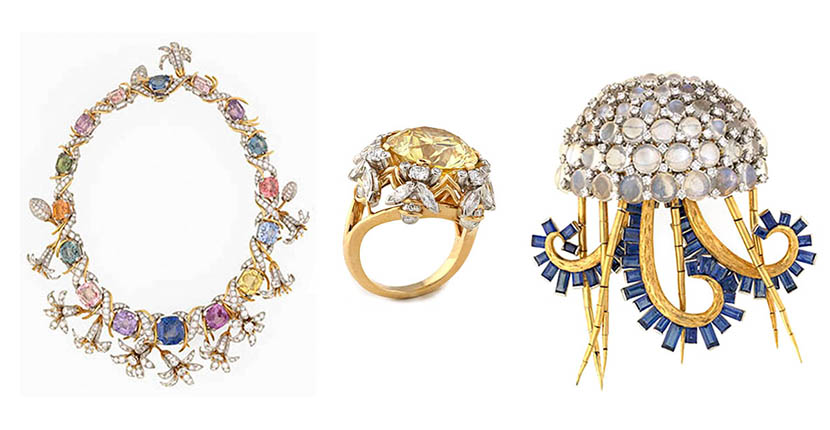
Bunny Mellon's Jasmine Necklace, Bees Ring and Jellyfish Brooch by Schlumberger from the exhibit at the Virginia Museum of Fine Arts Photo courtesy
Books & Exhibitions
Bunny Mellon’s Schlumberger Goes On Display
The exhibit includes over 135 jewels and objects
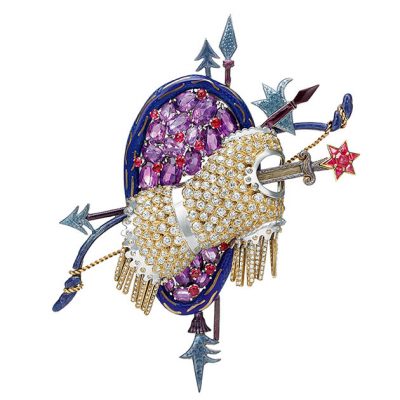
Diana Vreeland’s Trophée de Vaillance brooch by Jean Schlumberger Photo Tiffany & Co. Archives
February 10, 2017—Jean Schlumberger considered himself an anomaly in his field. “It’s very complicated,” he explained to Daniel Behrman, a reporter for Réalités in 1957, “I make jewels, but I hate modern jewelry—and I can’t tell people I make antique jewels.” For the French designer modern meant matching suites of diamonds set in abstract patterns. He described the look as “mainly a display of cash value.”
Schlumberger’s aesthetic was all about imagination. After he joined Tiffany as a signature designer in 1956, he became famous for his sea creatures, fantasy flowers and heraldic motifs set with an array of colorful gems accented by extraordinarily sculptural gold and platinum metalwork. A Renaissance spirit, some surrealist influences and a passion for nature inspired his jeweled flights of fancy.
The most stylish women in the world collected Jean Schlumberger during the height of his career. Elizabeth Taylor, Lauren Bacall, Babe Paley and Millicent Rogers were all clients. Fashion editor extraordinaire, Diana Vreeland reputedly kept her Trophée de Vaillance brooch by Schlumberger on her night table. The piece had a fringed breastplate, shield and spears conjuring up a medieval code of dress and honor. “It’s not at all subtle,” Vreeland once said of the design. “A Schlumberger lights up a whole room!” Jackie Kennedy wore her Schlumberger enamel bangles so frequently in the 1960s, the press dubbed the jewels, “Jackie Bangles.” The ruby two fruit clip by Schlumberger she received from John Kennedy to celebrate the birth of their son is part of the permanent collection at The Kennedy Library in Boston.
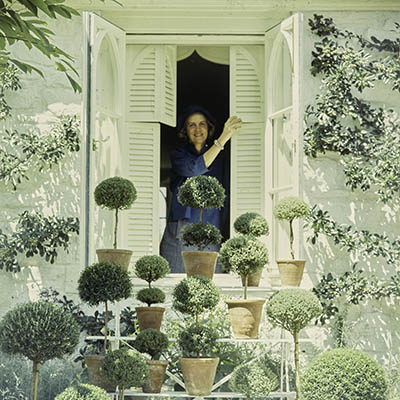
Bunny Mellon wearing her blue enamel bangle by Schlumberger in Horst shot for Vogue taken in 1965 Photo Conde Nast via Getty Images
Schlumberger’s most devoted client was the very private Bunny Mellon, otherwise known as Rachel Lambert Mellon. While it has long been common knowledge in jewelry circles, she had a substantial collection of Schlumberger’s work, exactly what or how many pieces she owned, has had the air of an urban jewelry myth. Unlike the other bold faced names who shopped with Schlumberger, Mrs. Mellon was rarely ever photographed at events wearing the major pieces. Her jewelry remained behind closed doors—until now.
Mrs. Mellon believed Schlumberger’s work was art. Only a couple of her Schlumberger items appeared in her estate sale at Sotheby’s in 2015. The rest—an astonishing 150 jewels and objects—were bequeathed by Mrs. Mellon to The Virginia Museum of Fine Arts in Richmond. The first exhibition of all the Schlumberger will be on display from February 10 to June 18, 2017. The installation is set up to study and enjoy the jewels. One brooch, for example, is in a case at the center of a table with chairs, pencils and pads for visitors to sit down and sketch the piece. It’s a wonderful detail Mrs. Mellon and Jean Schlumberger would have surely appreciated.
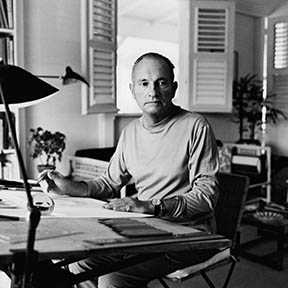
A 1971 shot by Horst of Jean Schlumberger at his drawing board in one of several small houses that make up his living space at Bisdary on Guadeloupe. Photo Condé Nast via Getty Images
Bunny Mellon and Jean Schlumberger were soulmates. They both came from privileged backgrounds. They preferred to keep their personal lives very private. They shared a passion for nature. And both were self-taught in the areas of their creative interests. For Schlumberger it was, of course, jewelry. Horticulture was Mrs. Mellon’s area of expertise. Her supreme gardening talents were such that Jackie Kennedy asked her to redesign the Rose Garden at the White House in 1961. The layout of the space is still very much as she conceived it.
According to Pierce MacGuire, whose acquaintance with Mrs. Mellon began when he took over the Schlumberger department at Tiffany in 1992 (five years after the designer passed away), “They were very close; she would sit with him and he would be drawing and things would happen.’’ Sometimes he created special commission pieces for Paul Mellon to give Bunny. Other times Schlumberger’s designs were inspired by an event in her life. She was most definitely his muse.
Several designs in the collection directly reference the twosomes’ shared passion for nature. The collection includes two Butterfly bracelets made in 1956 that do not match exactly but are similar in style. Each is set with amethyst, sapphires, turquoise, peridots and diamonds among other gems. The butterflies hover above the flowers and are set en tremblent to gently fly.
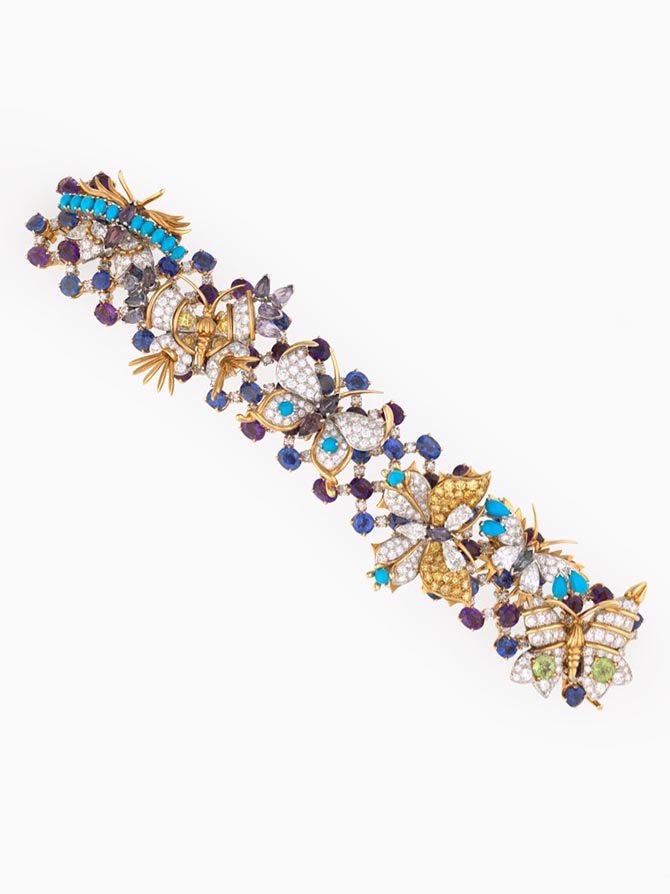
One of Bunny Mellon’s Butterflies Bracelets by Schlumberger Photo courtesy of The Virginia Museum of Fine Arts
The Jasmine necklace (in the photo at top), nicknamed Breath of Spring, by Mrs. Mellon has diamond flowers that wind around the 16 colored sapphires in a pattern that looks like they actually grew that way as opposed to being set by a jeweler in metal. “I wanted to capture the irregularity of the universe,” Schlumberger once said. “I observe nature and find verve.”
Mrs. Mellon’s Bees ring (in the photo at top) features an 8.8-carat fancy colored diamond, she gave Schlumberger to set in the jewel. The insect references the garden as well as the bee motif in Napoleanic coat of arms. The original rendition of the ring had been designed with two bees in 1971 for Prince Napolean, the pretender to the Imperial Crown of France, to give his fiancée.
The ingenious 1967 Jellyfish brooch (in the photo at top) features moonstones, diamonds, sapphire and 18K gold segmented limbs that move. “Schlum designed the Jellyfish after Mrs. Mellon was stung while swimming in the ocean at their home in Antigua at the Mill Reef Club,” explains Pierce. “She had her arm in a sling. He made the design after that and they loved it.”
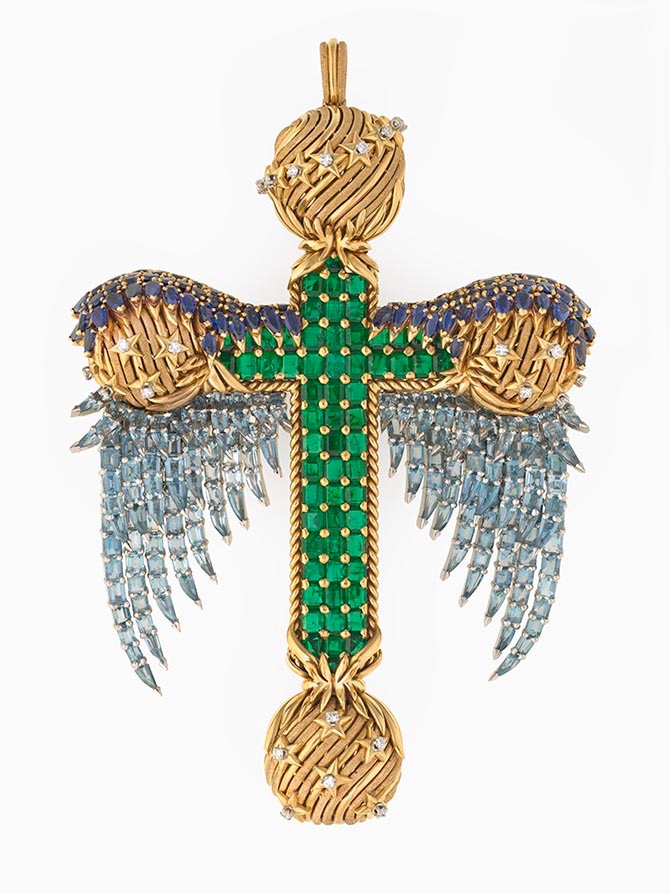
Bunny Mellon’s Pectoral Cross set with emeralds, sapphires, aquamarines, diamonds in 18K gold was designed by Schlumberger in 1960 Photo courtesy of The Virginia Museum of Fine Arts
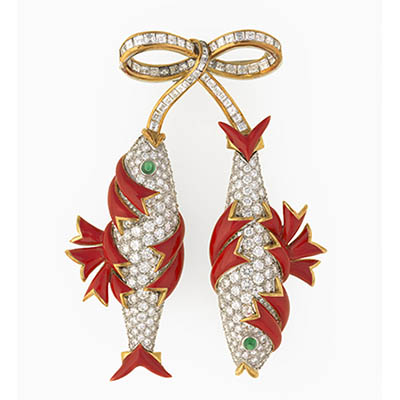
Bunny Mellon’s Pisces Brooch by Jean Schlumberger Photo courtesy of The Virginia Museum of Fine Arts
In addition to generous support of gardening and the arts, the Mellons also funded the construction of the Trinity Episcopal Church in Upperville, Fauquier County, Virginia. Mrs. Mellon’s faith is reflected in her Schlumberger jewelry collection. The Pectoral Cross is a breathtaking design made lyrical with the addition of wings and stars. “Rubies appeared in the original rendering,” says Pierce. “Yet the emeralds work much better in the finished jewel. They mesh harmoniously with the quietness of the aquamarines.”
Among all the jewels in the collection, the Pisces brooch with two diamond fish accented in red enamel was, according to a note Mrs. Mellon wrote to the museum, her favorite piece in the collection. For me, it is difficult to pick one or even two and call them the best jewels in show. Unlike, most collections where there is usually a couple of pieces that stand above the rest, there is an evenness to the high quality of Mrs. Mellon’s Schlumberger jewels. When I asked Pierce about the remarkable level of excellence throughout, he made an utterly divine analogy. “It was like when McKim, Mead & White was engaged to build the University Club in New York. They said, in essence, ‘we’ve got the money, let it rip.’ She allowed him to have creativity galore.”
Similar Stories:
Verdura’s New Collection Celebrates a Historic Collab with Dali
Italians Made the Best American Patriotic Jewels
A Brief History of Elegant Hands in Jewelry
Get a gem in your mailbox SIGN UP FOR THE ADVENTURINE NEWSLETTER




